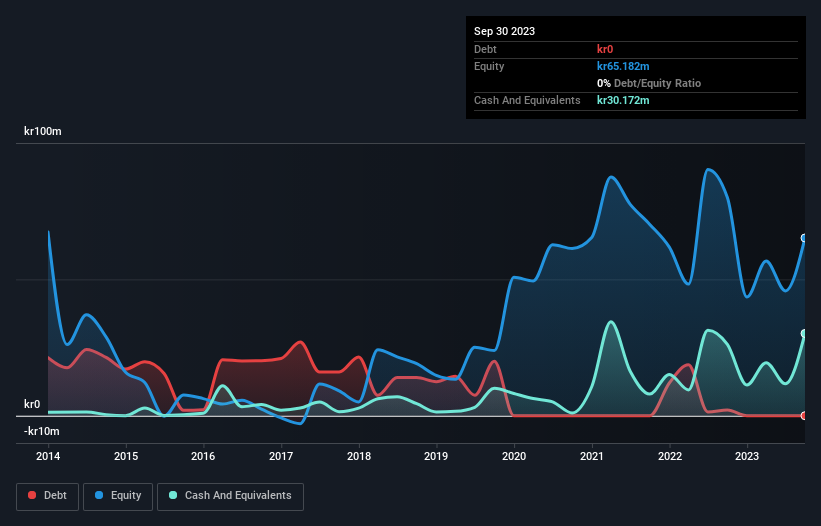- Sweden
- /
- Communications
- /
- OM:KEBNI B
Companies Like KebNi (STO:KEBNI B) Are In A Position To Invest In Growth
Just because a business does not make any money, does not mean that the stock will go down. For example, although software-as-a-service business Salesforce.com lost money for years while it grew recurring revenue, if you held shares since 2005, you'd have done very well indeed. But while the successes are well known, investors should not ignore the very many unprofitable companies that simply burn through all their cash and collapse.
So, the natural question for KebNi (STO:KEBNI B) shareholders is whether they should be concerned by its rate of cash burn. For the purposes of this article, cash burn is the annual rate at which an unprofitable company spends cash to fund its growth; its negative free cash flow. The first step is to compare its cash burn with its cash reserves, to give us its 'cash runway'.
View our latest analysis for KebNi
When Might KebNi Run Out Of Money?
A cash runway is defined as the length of time it would take a company to run out of money if it kept spending at its current rate of cash burn. In September 2023, KebNi had kr30m in cash, and was debt-free. Importantly, its cash burn was kr49m over the trailing twelve months. That means it had a cash runway of around 7 months as of September 2023. Importantly, the one analyst we see covering the stock thinks that KebNi will reach cashflow breakeven in around 16 months. Essentially, that means the company will either reduce its cash burn, or else require more cash. The image below shows how its cash balance has been changing over the last few years.

How Well Is KebNi Growing?
KebNi boosted investment sharply in the last year, with cash burn ramping by 82%. That does give us pause, and we can't take much solace in the operating revenue growth of 12% in the same time frame. In light of the data above, we're fairly sanguine about the business growth trajectory. While the past is always worth studying, it is the future that matters most of all. So you might want to take a peek at how much the company is expected to grow in the next few years.
How Easily Can KebNi Raise Cash?
Given the trajectory of KebNi's cash burn, many investors will already be thinking about how it might raise more cash in the future. Companies can raise capital through either debt or equity. Commonly, a business will sell new shares in itself to raise cash and drive growth. We can compare a company's cash burn to its market capitalisation to get a sense for how many new shares a company would have to issue to fund one year's operations.
KebNi's cash burn of kr49m is about 16% of its kr302m market capitalisation. As a result, we'd venture that the company could raise more cash for growth without much trouble, albeit at the cost of some dilution.
How Risky Is KebNi's Cash Burn Situation?
Even though its cash runway makes us a little nervous, we are compelled to mention that we thought KebNi's revenue growth was relatively promising. It's clearly very positive to see that at least one analyst is forecasting the company will break even fairly soon. While we're the kind of investors who are always a bit concerned about the risks involved with cash burning companies, the metrics we have discussed in this article leave us relatively comfortable about KebNi's situation. Taking an in-depth view of risks, we've identified 4 warning signs for KebNi that you should be aware of before investing.
Of course KebNi may not be the best stock to buy. So you may wish to see this free collection of companies boasting high return on equity, or this list of stocks that insiders are buying.
Valuation is complex, but we're here to simplify it.
Discover if KebNi might be undervalued or overvalued with our detailed analysis, featuring fair value estimates, potential risks, dividends, insider trades, and its financial condition.
Access Free AnalysisHave feedback on this article? Concerned about the content? Get in touch with us directly. Alternatively, email editorial-team (at) simplywallst.com.
This article by Simply Wall St is general in nature. We provide commentary based on historical data and analyst forecasts only using an unbiased methodology and our articles are not intended to be financial advice. It does not constitute a recommendation to buy or sell any stock, and does not take account of your objectives, or your financial situation. We aim to bring you long-term focused analysis driven by fundamental data. Note that our analysis may not factor in the latest price-sensitive company announcements or qualitative material. Simply Wall St has no position in any stocks mentioned.
About OM:KEBNI B
KebNi
Develops, produces, and sells products and applications for stabilization, navigation, and satcom worldwide.
Exceptional growth potential with flawless balance sheet.
Market Insights
Community Narratives



